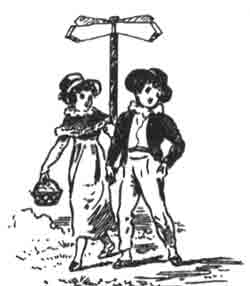Ulster-Scots as manifest in placenames

David Polley
Historical placenames
As different languages ebb and flow across the landscape, their vocabularies are used to describe places and features. These words, once merely descriptive, become proper nouns, and thus achieve an independence from the fate of the language itself. We can talk about “an archaeology” of names — different layers of names laid down at different times — and by excavating this we can begin to understand something of how people used to speak. Thus if a language is in retreat across a territory, there will still be names left behind locked in the linguistic landscape and recorded on maps. Although Gaelic has received most attention, being found across the entire island of Ireland, Ulster-Scots has also left a trace in our nomenclature. As with all such names this can be understood to occur at three different levels:
Official names
Legal names such as parish names and especially townland names. Kirkinriola in Co Antrim (“Riola’s Church”) is perhaps the only definite parish name showing Ulster-Scots influence. It was an adaptation in a strong Scots area of the Gaelic Cill-, which means the same as the Scots. Townland names are more numerous: Black Brae in Co. Londonderry (a brae is a slope often, but not always, near water), Cunningburn in Co Down (burn is so commonly used for stream in Scots areas that it is barely thought of as unusual), and perhaps even Glar in Co. Donegal (glar is soft mud and this is a townland reclaimed from the sea).
Recorded local names
Many other names are recorded in official sources, although they have no legal importance. There are many such names on the OS six-inch maps, while others are recorded in the OS name books, although they were not chosen for inclusion on the final copies. Distribution maps of common Scots words such as burn or moss “peat bog” could show where these words were of important local currency in the early nineteenth century.
Unrecorded local names
The whole country is covered with a quite mind-boggling wealth of local names and associated folk tales. Although little research has been published at this level, that which is available indicates the diversity and amount of potential material. Indeed one entire book (Cathain 1975) contains information about only one townland in the Galway Gaeltacht. Other writers have pointed out the importance of local names in local history (Malley 1977), although neither of these publications dealt with specifically linguistic issues. Previous issues of Ullans have carried articles on local placenames around Greyabbey, and the Northern Ireland Placenames Project has recently completed a survey in East Antrim and Portaferry. In the near future we should be able to assemble a thorough range of sources for all of Ulster, and begin to examine the distribution of words such as roddin “grass lane” holme “flat land by a river” or march “a farm boundary” (though this latter is not Scots, but the West Country dialect of English).
Using a combination of distribution maps of various name elements at these three different scales, we should be able to gain insights into the linguistic influence of Ulster-Scots throughout history. In addition, we can record names which might otherwise be lost, and empower people to realise the value of their local language and traditions. Perhaps most important of all, we can contribute to the debates regarding Irish placenames and work with Gaelic scholars to show the true diversity of our common heritage on this island. Many placenames have a variety of possible meanings; the previously mentioned kirk is also thought to be present as a surname and as a modification of the Gaelic word for “hen” or “moorhen” (cearc).
Modern placenames
Recently there has been an upsurge of interest in Ulster-Scots placenames linked to government legislation allowing bilingual street signs. The sort of research mentioned before will be invaluable in this respect as we can provide real, organic Scots names for roads now built up and renamed. For example, Brunswick Road in Bangor was previously known as Ash Loanen. I believe that encouraging these historical names to reappear is preferable to the translation of current English names. Of course, many recent housing developments are not on historical routes, in which case we could use field names or other local names as our Ulster-Scots versions for these streets. Surely only as a last resort should we translate English into Scots, although in many long developed areas it may be unavoidable. An additional advantage is that it is less difficult to have heritage signs erected, thereby speeding the increased visibility for the language which road signs achieve.
Perhaps more important, however, is our chance, through the promotion of Ulster-Scots, to encourage new developments in Scots areas to be called by Ulster-Scots names. Since many councils have announced that they are trying to use more traditional and locally resonant names in new developments we can surely look forward to a marked increase in Scots in our built environment.
Next: Guid Wittens o Jhone
Previous: Peter an tha Wulf
Contents: Ullans: The Magazine for Ulster-Scots, Nummer 7 Wunter 1999

